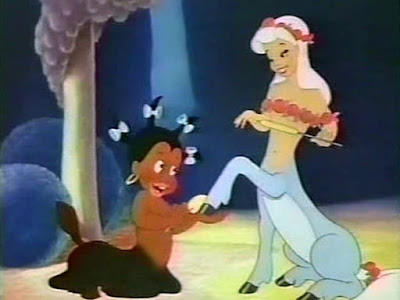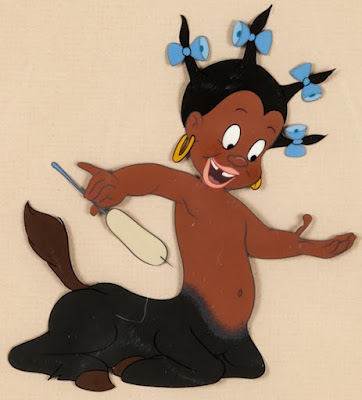Thursday, July 19, 2018
Racism or erase-ism? The dilemma of Sunflower
Wednesday, November 20, 2013
Thursday, October 31, 2013
Thursday, April 4, 2013
I TOLD you Disney was a ripoff!
From Murnau's 1926 silent masterpiece, FAUST
From Disney's FANTASIA: running low on ideas, boys?
http://www.amazon.com/-/e/B001K7NGDA
Thistledown Press
Saturday, August 13, 2011
In the garden of good and evil
I tried to find the original documentary, came up empty (it barely exists on DVD, and only in Europe and only in French. I shall have to wait.) Then I thought about Night on Bald Mountain, one of the most celebrated pieces from Fantasia, and how many images Disney "borrowed" from Murnau's creepy classic from 1926, Faust.
The hideous horsement (whom I saw on TV many years before, an isolated clip that only made sense to me 25 years later); the big scary guy wit' da wings, and lots of other stuff. But I didn't want to post a 9-minute clip from Fantasia, so then I got watching the Ave Maria that follows after: try as I might, I can't diss this, as the animation is so utterly otherworldly. Yes, Disney is strutting his animated stuff, saying, look, have you ever seen animation like this? No. And we never will again.
But THEN I found this rendition of Ave Maria by Barbara Bonney, and I have to say it is the finest I have ever heard. I heard her sing Peer Gynt many years ago (in fact I still have a recording of the complete work, with Norwegian dialogue) and loved her voice, but I have to say I never cultivated her properly, so it's good to hear this.
The visuals in this are crummy, but that makes you shut your eyes and really listen. THIS kind of good really could defeat Faust's evil forces.
(Sorry this came out in such awkward order. The video kept disappearing or half-appearing or otherwise getting screwed up, so it's under the post A pool of stillness: Barbara Bonney's Ave Maria.
Sunday, August 22, 2010
Ding, dong, ding, dong, ding, dong, ding, dong. . .
I'm really sorry about this, but some evil seed in me made me post it.
This is what kids' TV was like in the '50s. I have dim memories of Miss Frances, but mostly I remember my older brother making horrible, hilarious fun of her.
She speaks in a dragging voice, repeats everything ad nauseam, and generally acts as if she's facing an audience of drooling subhumans. When I showed a bit of this to my 6-year-old granddaughter (no doubt the target audience back then, though it probably went up to age 10 or 11), her jaw went slack and her eyes glazed over. She looked at me doubtfully and asked, "Was this a real show?"
It does resemble satire, does it not? She must repeat the instructions for her fantastically difficult sandwich 5 or 6 times. "Bread, peanut butter, and. . . what was the other one? You can't remember?" I think this was originally a PBS show. Or something. It makes Captain Kangaroo look like he was shot out of a cannon.
I've seen the sort of thing Caitlin watches: Disney productions such as The Suite Life of Zack and Cody (male duos being inexplicably popular, along with females with special powers: hey, let's give the girls some good role models! Except that they're always princesses). They're snappy, every line a joke, incredibly fast-moving and full of silly, pie-in-the-face gags. They also feature washed-up character actors like John Schuck (the butt of every joke in the show I saw yesterday). There is an invisible line between Tree House (a Canadian preschool channel featuring Max and Ruby, Toopy and Binoo, and Dora the Explorer) and Disney Channel fare, but once you've crossed it, you'll never turn back.
Well, in MY day we did things differently. Until the advent of snappy shows such as Roger Ramjet, Bullwinkle, Underdog, Linus the Lionhearted, Alvin and the Chipmunks and Superchicken, we watched Captain Kangaroo, a show almost as primitive as Miss Frances' lunatic asylum fare. At least there were other characters involved: Mr. Moose; Bunny Rabbit; Grandfather (the clock, who only woke from his slumber if you said, "One, two, three. . . Grandfather!"), and the ubiquitous Mr. Green Jeans. There were little skits, usually ending with a thousand ping-pong balls falling on the Captain, and also little -what were they, anyway? Vignettes? If I could find a video, I'd post it, but most of these shows went out live and disappeared forever.
There'd be a pre-recorded song, with a disembodied pair of hands doing actions, or trains made of construction paper being dragged across a backdrop of green felt. One of them was about Four Little Taxis: "a yellow one, a green one, a blue one, a purple one!" One by one, the cardboard taxis drove away, until there were "no little taxis sitting on the curb. . . no yellow one, no green one. . ." It was heart-wrenching. But then the narrator would lift us out of our despair: "But wait! The taxis are coming back!" That's about as traumatic as the show got.
I only remember fragments, with fuzzy acres of oblivion in between. Binnie, the Magic Bunny. A song about Dallas (obviously, before the Kennedy assassination): "Big D, little-a, double-l-a/Big D, little-a, double-l-a". These soul-deadening little productions were enlivened by Tom Terrific and his pal, Mighty Manfred the Wonder Dog: cartoons made of line drawings that moved with all the sophistication of a flip-book.
And the crafts! We loved to make fun of the Captain's nasal, Brookly-esque accent as he talked about "cahhhd-bwwoaaaad" and making pumpkins out of paper that was "aaaaah-raaaahnge". He used paper fasteners on everything, especially things that were supposed to twirl around. We couldn't even find paper fasteners. They're lame metal things that sort of spread out, and they certainly don't allow for twirling. But sometimes we found a big "cahhhd-bwwoaaaad" box in the garage and began to cut windows in it with a steak knife, usually with disastrous results.
OK, so what did all this do to aid the developlent of the average kid-brain in that era? Not much. When the smart-ass cartoons of the mid-to-late '60s came along, they were more than welcome. Beany and Cecil always operated on two levels (like most kids' movies do today), and there were references only the adults would get. Supposedly. When we recently saw a show with a Chinese prince in it, I said, "Hey, maybe that's Prince Chow Mein." Caitlin laughed uproariously, immediately getting a joke that would have sailed over my head in l963. (As a matter of fact, I stole it from Beany and Cecil.)
Kids don't get to choose their entertainment. Some bigwig moguls up at Disney sit around a table, and maybe have focus groups/guinea pigs testing it all out. Is it "better", "worse", or just different? It's fast. Fast-fast-fast, and all sort of run together, so you won't notice there's no story.
Girls are reaching puberty when they're still in the Jolly Jumper these days, and no one knows why. If they weigh 200 pounds, it's genetic and nothing to do with the fact that they live exclusively on sugar and fat (but the Twinkies are fortified with Vitamin C). If they're exposed to Lady Gaga flashing her crotch every 2 seconds, it has no effect. If their parents are so preoccupied with hanging on to their second-rate, fading careers that the kids spend 11 hours a day sexting each other and planning to commit suicide on Skype, hey, that's just life in 2010.
If they're being raised by the TV, well, hey, wasn't I raised by the TV too? I think that explains everything.
*****************************************************
POSTSCRIPT. With my usual ferretlike curiosity, I dug up many more Miss Frances clips, incuding a whole episode in which she takes off her watch to fingerpaint. At the end of these sessions, she'd tell the kiddies to drag their mothers in to listen to her lecture on proper parenting (mothering, back then), while they ran outside to play. This one stressed the need for the children to "rest". They played so hard, Miss Frances claimed, that when they came back in the house, they just played some more and wore themselves right out!
We won't get into the fact that, with rare exceptions, kids weren't fat then because they were outside running their little legs off. In fact, the need to REST seems totally foreign today. "Make sure that the children lie down for a little while on the davenport," she said.
DAVENPORT?? What the hell is that? I had to look it up. I used to think "chesterfield" was out of date.
















